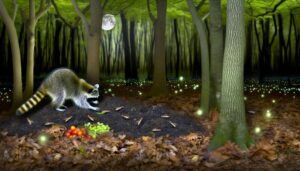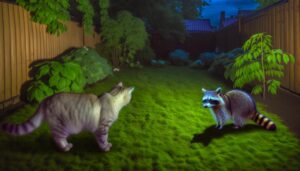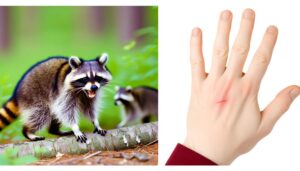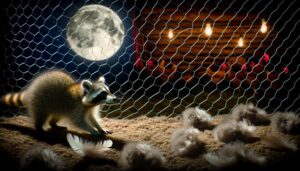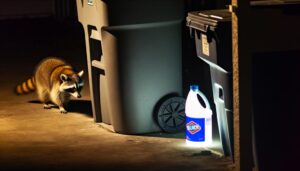How Do Squirrels Get Raccoon Roundworm?
Squirrels acquire raccoon roundworm, Baylisascaris procyonis, mainly by ingesting infective eggs present in raccoon feces. These eggs contaminate soil, water, and food sources that squirrels encounter while foraging.
Once ingested, the eggs hatch into larvae, which penetrate the intestinal wall and migrate to various tissues. Environmental factors such as habitat overlap, warm climates, and seasonal variations also influence transmission rates.
Foraging patterns and nest-building behaviors further expose squirrels to contamination. Effective mitigation strategies include improving environmental hygiene and wildlife management practices.
By understanding these dynamics, you can gain deeper insights into preventing this zoonotic transmission.
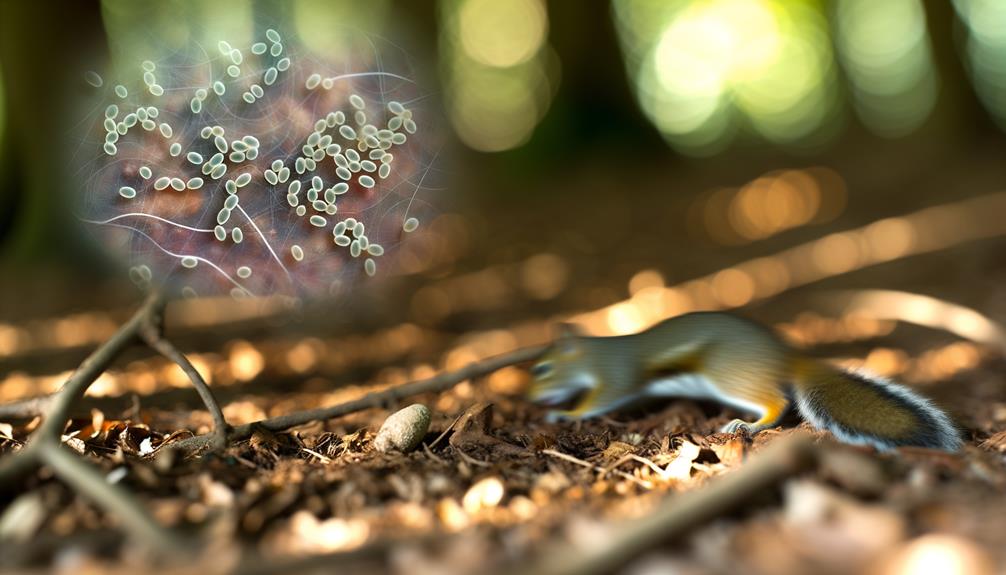
Key Takeaways
- Squirrels ingest roundworm eggs while foraging in contaminated soil, water, or food.
- Raccoon feces containing infective eggs contaminate the environment where squirrels forage.
- Squirrels ingest roundworm eggs during grooming activities when eggs adhere to their fur.
- Nest-building with contaminated materials exposes squirrels to roundworm eggs.
- Habitat overlap with raccoons increases the likelihood of squirrels encountering roundworm eggs.
Understanding Raccoon Roundworm
Raccoon roundworm (Baylisascaris procyonis) is a parasitic nematode primarily found in raccoons but capable of infecting a variety of other mammals, including squirrels and humans. This nematode poses significant health risks due to its zoonotic potential.
The larvae can migrate through different host tissues, causing visceral, ocular, and neural larva migrans, which may result in severe neurological damage. Epidemiological data indicate that the prevalence of Baylisascaris procyonis in raccoon populations can reach up to 68-82% in certain regions.
Understanding this parasite's biology is essential for mitigating its impact on public and veterinary health. Surveillance and control measures, such as deworming raccoons and educating the public about potential risks, are vital for preventing transmission and safeguarding susceptible species.
Life Cycle of Baylisascaris Procyonis
The life cycle of Baylisascaris procyonis begins with the deposition of eggs in raccoon feces, which contain the embryonated larvae.
Upon ingestion by intermediate hosts, such as squirrels, the larvae hatch and undergo somatic migration, eventually encysting in various tissues.
This transmission mechanism facilitates the propagation of the parasite, posing significant ecological and health risks to both wildlife and humans.
Eggs in Raccoon Feces
Baylisascaris procyonis, a parasitic nematode, begins its life cycle when eggs are excreted in raccoon feces. These eggs play an essential role in the transmission and propagation of the parasite. The process involves several key steps:
- Egg Excretion: Raccoons, the definitive hosts, shed millions of eggs in their feces.
- Environmental Dissemination: Eggs become dispersed in the environment, contaminating soil, water, and vegetation.
- Egg Viability: Eggs can remain viable and infectious in the environment for months to years, increasing the risk of transmission.
- Accidental Ingestion: Non-host species, such as squirrels, inadvertently ingest these eggs while foraging, leading to potential infection.
This stage sets the foundation for the parasite's further development and subsequent infection of intermediate hosts.
Larvae Development Process
Upon ingestion by intermediate hosts such as squirrels, Baylisascaris procyonis eggs hatch into larvae within the host's intestines, initiating a complex developmental process.
These larvae then undergo visceral larval migrans, penetrating the intestinal wall and migrating through various tissues, including the liver, lungs, and central nervous system. Studies indicate that larvae can cause significant pathological damage during migration, leading to severe neurological and organ dysfunction.
Research has shown that up to 80% of larvae can persist in tissues, remaining viable for years. This persistence contributes to chronic infection and increased mortality in affected squirrels.
Understanding the larvae's development and migration patterns is essential for devising effective interventions to mitigate the impact of Baylisascaris procyonis on wildlife populations.
Transmission to Squirrels
Understanding the transmission of Baylisascaris procyonis to squirrels requires a detailed examination of its life cycle, encompassing egg dissemination by raccoons and subsequent ingestion by intermediate hosts.
The life cycle of this parasitic nematode involves multiple stages:
- Egg Release: Raccoons excrete eggs through their feces, contaminating the environment.
- Egg Maturation: Under favorable conditions (moisture, temperature), eggs become embryonated and infectious within 2-4 weeks.
- Ingestion by Squirrels: Squirrels inadvertently consume these infectious eggs while foraging.
- Larval Migration: Once ingested, larvae hatch, penetrate the intestinal wall, and migrate to various tissues, causing visceral and neural larva migrans.
This cyclical process underscores the importance of environmental hygiene and wildlife management in mitigating zoonotic transmission dynamics.
Common Transmission Routes
Numerous studies have identified ingestion of contaminated soil, water, or food as primary transmission routes for raccoon roundworm (Baylisascaris procyonis) to squirrels. This nematode's eggs are commonly shed in the feces of infected raccoons, subsequently contaminating the environment.
Squirrels, foraging for food, inadvertently ingest these infective eggs. Research indicates that even minimal exposure to contaminated substrates can result in transmission, emphasizing the pathogen's high infectivity rate.
Additionally, data corroborate that interspecies interactions, where squirrels encounter raccoon latrines, notably elevate the risk of infection. The pervasive nature of raccoon roundworm in raccoon populations, combined with the opportunistic feeding habits of squirrels, creates a persistent transmission vector within overlapping ecological niches.
Environmental Factors
Environmental factors significantly influence the prevalence and transmission dynamics of raccoon roundworm in squirrel populations. These factors determine the extent of raccoon roundworm (Baylisascaris procyonis) contamination in specific areas.
- Habitat Overlap: Areas where squirrel habitats intersect with raccoon territories show increased contamination levels due to shared spaces.
- Climatic Conditions: Warm and humid environments facilitate the survival and spread of roundworm eggs, enhancing transmission risk.
- Seasonal Variations: Egg shedding by raccoons peaks in certain seasons, correlating with higher infection rates in squirrels.
- Human Encroachment: Urbanization and deforestation lead to habitat fragmentation, increasing contact between raccoons and squirrels, thereby elevating transmission opportunities.
Addressing these factors requires an integrated approach to wildlife management and environmental stewardship to protect vulnerable species.
Squirrel Behaviors
Squirrel behaviors, such as foraging patterns, nest-building habits, and grooming activities, play a vital role in the transmission dynamics of raccoon roundworm (Baylisascaris procyonis).
During foraging, squirrels often encounter raccoon latrines, which are common sites for B. procyonis eggs. Nest-building frequently involves the collection of soil and leaf litter, potentially contaminated with these eggs.
Additionally, grooming activities can result in the ingestion of roundworm eggs adhered to their fur. Studies indicate that 23% of squirrels in endemic areas exhibit exposure to B. procyonis, highlighting the importance of these behaviors.
Understanding these patterns is essential for developing effective strategies to mitigate the risk of transmission, contributing to the health and well-being of both wildlife and human populations.
Preventative Measures
Implementing preventative measures is essential to mitigate the risk of raccoon roundworm transmission among squirrel populations. Ensuring clean feeding areas can markedly reduce contamination with Baylisascaris procyonis eggs.
In addition, promoting safe nesting habits can further decrease the likelihood of exposure to infected raccoon fecal matter.
Clean Feeding Areas
Maintaining clean feeding areas is crucial in minimizing the risk of raccoon roundworm transmission to squirrels. This parasitic infection, caused by *Baylisascaris procyonis*, can be lessened through stringent hygiene practices.
To secure feeding areas remain uncontaminated and safe, consider the following:
- Regular Cleaning: Clean feeding stations daily with a disinfectant to eliminate potential roundworm eggs.
- Food Storage: Store squirrel feed in sealed containers to prevent access by raccoons.
- Feeding Location: Position feeding areas away from known raccoon habitats to decrease cross-species contact.
- Waste Management: Promptly remove uneaten food and debris, which can attract raccoons and other vermin.
These measures, supported by empirical data, are crucial to maintaining a safe environment for squirrel populations.
Safe Nesting Habits
To mitigate the risk of *Baylisascaris procyonis* infection, establishing safe nesting habits for squirrels is paramount. Data indicates that primary prevention includes selecting nesting sites away from raccoon habitats, as these are vectors for the parasite.
Squirrel nests should be elevated and constructed in tree cavities or high branches to limit ground exposure, where raccoon feces containing infective eggs are prevalent. Regular inspection of nesting areas for raccoon activity is also advised. Utilizing barriers or deterrents can further reduce the likelihood of raccoon intrusion.
Additionally, promoting natural predators of raccoons through ecosystem management can aid in maintaining a safe environment. These measures collectively contribute to a significant reduction in the risk of infection, thereby safeguarding squirrel populations.
Conclusion
The pervasive threat of raccoon roundworm, Baylisascaris procyonis, to squirrel populations is a monumental concern in wildlife pathology.
The intricate life cycle and various transmission routes, exacerbated by environmental factors and specific squirrel behaviors, underscore the complexity of this parasitic menace.
Rigorous preventative measures are imperative to mitigate the devastating impact on ecosystems.
The magnitude of this issue demands unprecedented attention and action from the scientific community to safeguard biodiversity and ecological balance.

